Bees houses are not your average garden or yard feature but they’re easy to find and maintain. Never had one? You’re missing on a lot of fun, to say nothing of the benefits of keeping bees.
In this easy guide, we’ll share with your bee house types and ideas and show you how easy it is to make your own from readily available materials. Join us in our quest to help the bees keep our planet healthy!
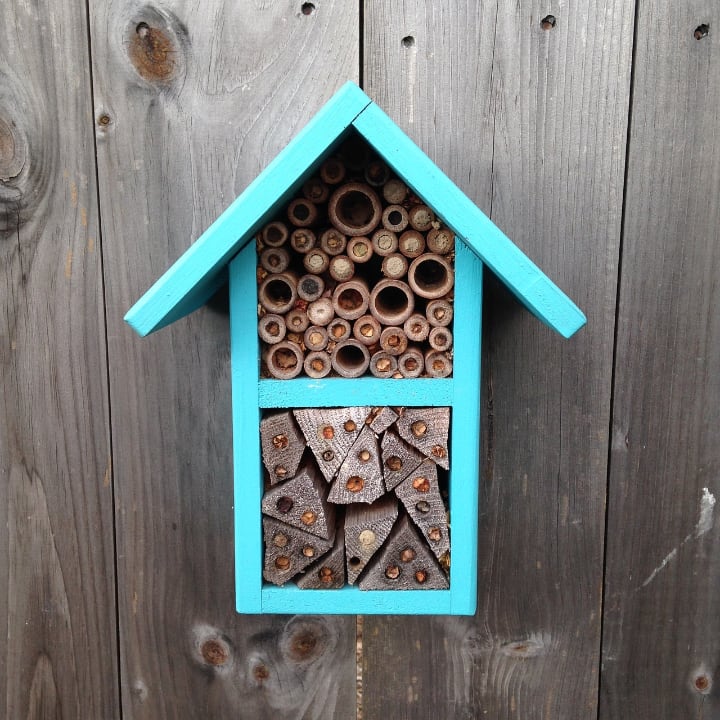
Bees houses are a great way to introduce a little more nature into your life, as well as boost the health of your backyard or garden. Not only that, but they can also provide bees with a comfy home.
They are easy to set up and you won’t be losing much time looking after it. Remember, a bee house is not a bee hive!
What Is a Bees House?
A bees house, as the name suggests, is a wooden structure in which bees build their nests and lay eggs. It’s is very similar to a bird house, except it attracts solitary bees rather than birds.
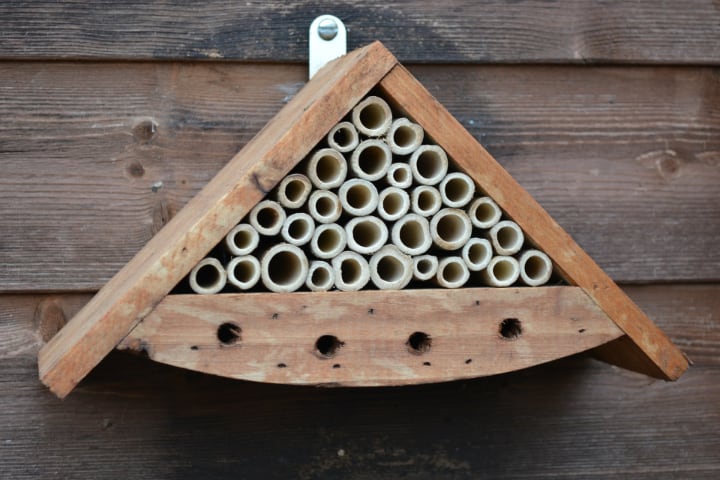
A bees house is usually a box filled with tiny tubes made out of various materials (e.g. bamboo, cardboard, or even plastic).
The tubes need to be big enough for a bee to get in and build a nest, but small enough to prevent predators, like wasps, from getting in.
Is a Bees House the Same as a Bees Hotel?
Not exactly. Although the terms are used interchangeably, a bees house usually refers to a smaller structure, whereas a bees hotel to a larger, more accommodating one.
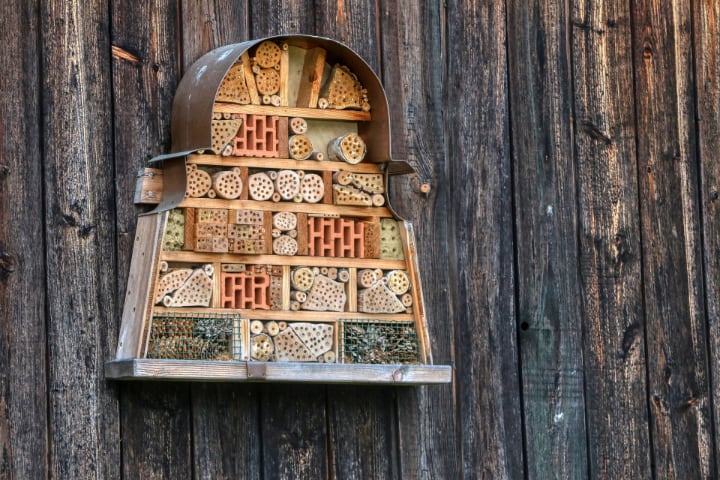
A bees hotel may also be built inside a larger structure and separated according to the types of bees you want to attract.
Benefits of a Bees House
There are several benefits to building bees a house, both for you and the bees. If you’re still on the fence about getting a bees house, the following benefits may convince you.
Keeps Bees Safe from Predators
Predators harm and kill bees, which is what has led to the bee crisis that the world is currently facing. Exposure to predators can also introduce diseases among the bees, which affects their lifespan.
Common bee predators include bears, skunks, bee eater birds, or crab spiders, to name only a few.
Leads to Better Pollination in Your Garden or Yard
Living near bees (especially solitary or orchard bees) helps boost the health of the flowers and plants in your garden.
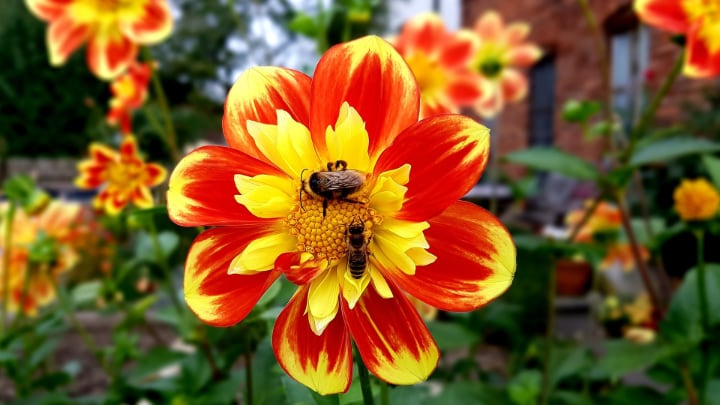
These bees tend to be better pollinators than the honeybee. In other words, a bees house can provide better pollination than keeping a beehive.
Protects the Bee’s Nest from The Weather
Traditionally, bees build their nests in tree trunks and protected places, precisely to keep rain and harsh weather from damaging their home.
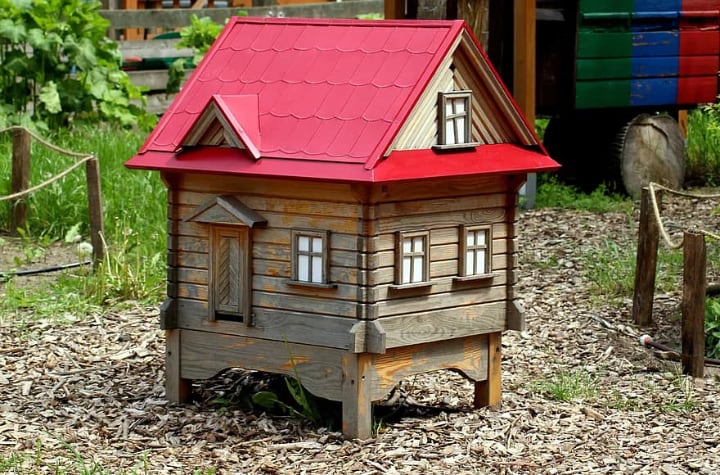
A bees home does that even better, as it’s built with durability and resistance in mind (more so than a bee’s nest can be).
Ensures That the Bees Have Food and a Constant Water Source
The world is facing a real bee crisis, one that affects not so much the honeybee as the solitary bee species.
By providing a secure home and a constant source of food and water, you are “doing your bit” to relieve this crisis.
Types of Bees Houses
We mentioned earlier that bees houses are designed for solitary bee species, but there’s more to it than that. In general, bees houses differ based on the type of bee they’re meant to attract.
Honey Bee House
If you see this term thrown around, know that a honey bee can not live in the same type of bees house as the other bees here. Honey bees are social by nature, and they need to live with other bees, in a hive.
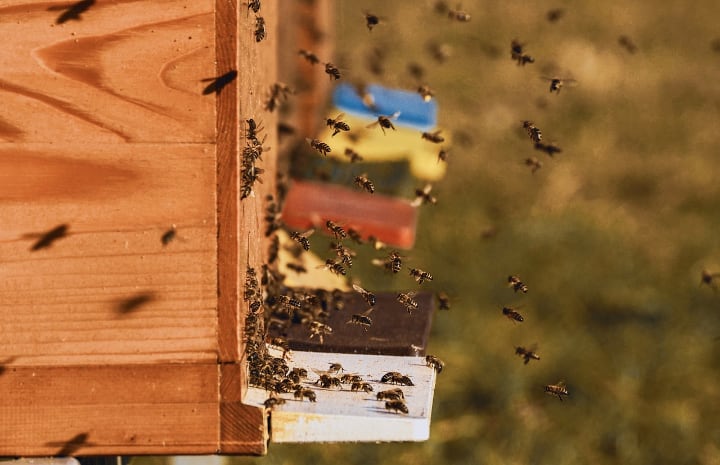
If you’re looking to attract a honey bee to your garden, your best bet would be to purchase a honey bee nest and go from there.
Bumble Bee House
Similarly to honey bees, bumble bees are also social and tend to live in groups, as part of a hive that follows a queen.
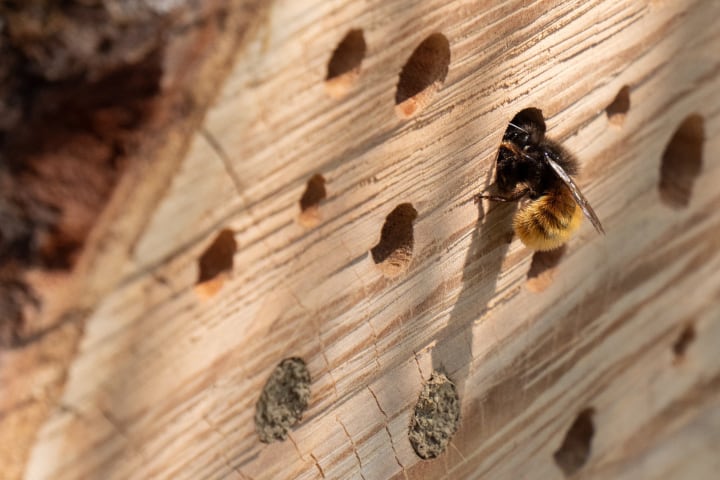
Although it’s long been believed that bees houses and nesting boxes can successfully attract bumble bees and encourage them to set up a nest, a 4-year long study proved the contrary.
Over the extensive period of that study, the designated bees homes intended to attract bumble bees showed no sign of bee inhabitants.
Solitary Bee House
A solitary bee isn’t just a bee who has lost its way from the hive, but rather a bee that lives alone by nature. It is different from a honey bee, as it does not live in a hive to begin with, follows no queen, and doesn’t make honey.
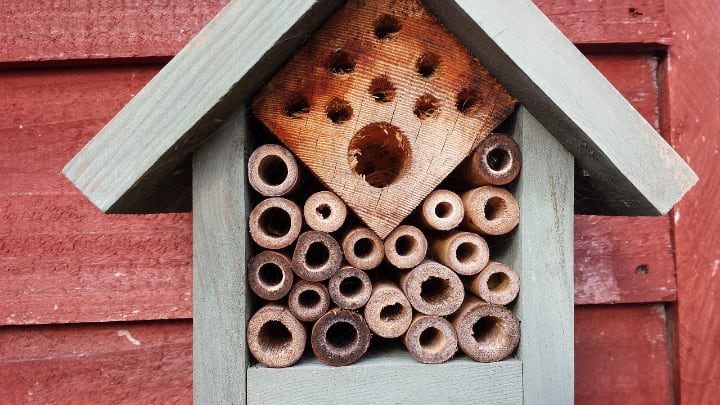
However, a solitary bee is known for its docility (it’s generally far more gentle than a honey bee) as well as its efficiency as a pollinator.
This is why most people build bees houses in their yards in the first place, to benefit from better pollination and a thriving garden.
Tip: Your best chance at improving pollination and attracting bees to your house is to set up a house specifically for solitary bees.
Mason Bee House
The mason bee is similar to the solitary bee. After mating, it finds a tube to nest in (and so would be attracted to a bees house).
The mason bee then proceeds to scoop up mud with her big jaws and uses it to build a wall at the back of the tube. This is why it’s called a mason bee.
The mason bee then collects nectar and deposits it into a heap at the end of the tunnel, for the baby bee to eat once it has hatched.
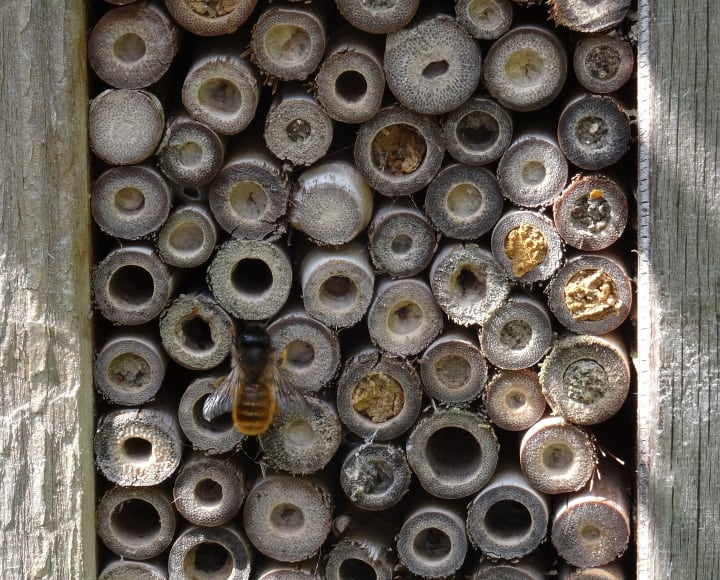
The mason bee then deposits the egg on top of the pollen, gets more mud, and seals off the egg into its own chamber.
It will do this until the entire tube is filled, and it will seal off the other end of the tube, to protect her babies from predators.
Mason bee homes and solitary bee homes are quite similar, and since they’re the main guests of your bees house or hotel, we’ll be focusing on them from now on.
Bees House Ideas
There are many ways in which you can build a bees house, ranging from the stylish and complex, to the surprisingly cheap and easy.
Canned Bee House
As the name suggests, a canned bee house is constructed inside a tin can.
Simply clean the can after you’ve used its contents and fill it with hollow/ dead plant stems. Careful though, you want the stems to be small (roughly 4-5mm), to deter predators.
Cinder Block Bee House
Cinder blocks are easy to find and make for excellent protection against the weather. Similar to the canned house, fill the cinder block with small, dead stems.
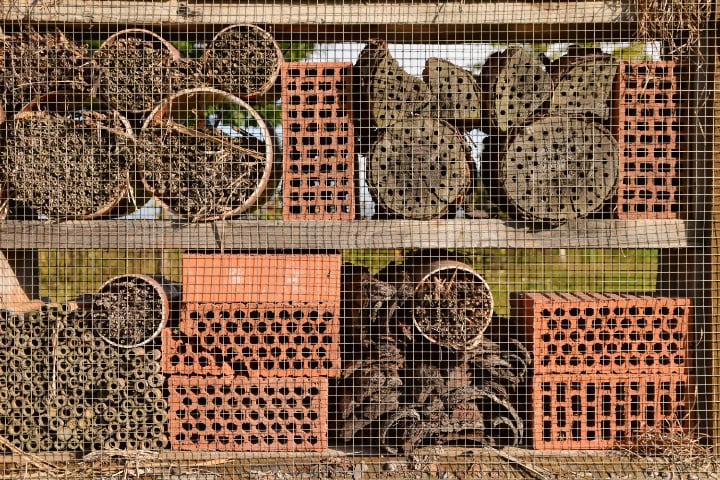
Make sure to place the cinder block standing up, so that both ends of the stems are open.
Drilled Bee House
If you’re handy with a drill, you can DIY a bees house by simply drilling a few small holes into a wood log.
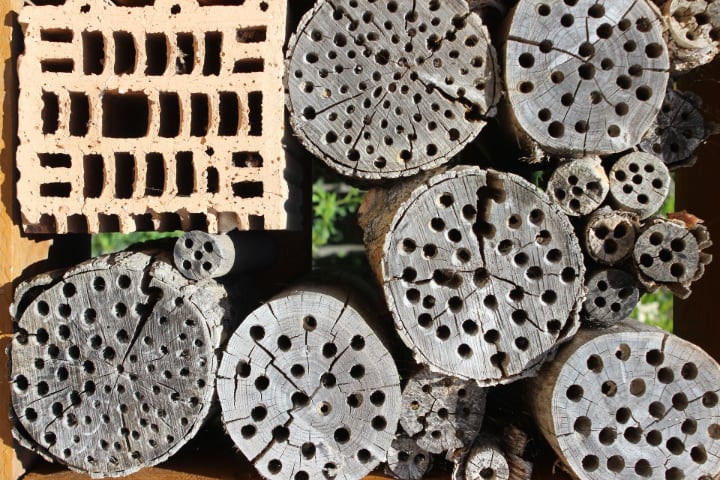
When drilling a bee house, keep the holes about 4 mm small, and make sure you don’t drill to the end, as that will deter bees from approaching.
Tip: Make sure there are no splinters inside the holes, as they may injure the bees.
Cardboard Bee House
If you don’t know where to get hollow stems, that’s not a problem. Simply use rolled up cardboard (or even paper) instead, and place it either inside a tin, a wooden box, or even a cut-out plastic bottle.
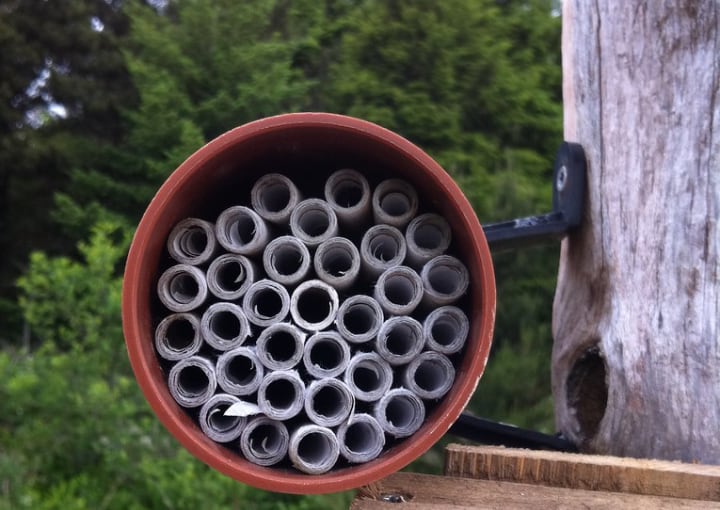
Bee House with a Roof
A roof isn’t just an aesthetic addition to your bees house. A good, sturdy roof makes rain and hail slither down, and protects the box with the bees nests better.
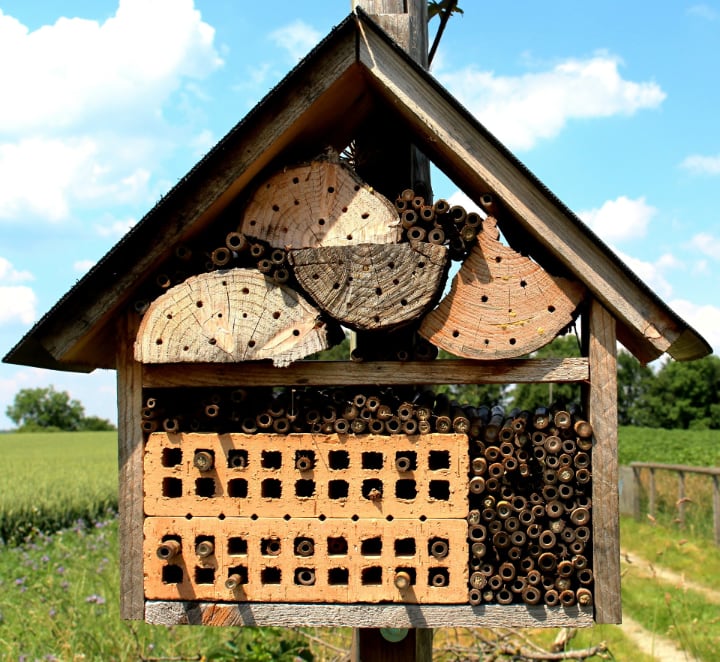
So, regardless of what method you’re using to make a bees home, consider adding a roof.
Bee House in a Mug
This is not only efficient, but it’s a really pretty addition to your garden, too. Simply stuff an old ceramics mug full of hollow stems or carboard/paper rolls and hang it off a branch in your yard.
If the color scheme of the mug fits the colors in your garden, all the better!
How to Build a DIY Bees House
Feeling ready to build your own bees house? Great!
In this easy DIY guide, we’ll show you the best and most efficient way to build the perfect bees home.
Tip: Expensive isn’t always better. You can make an effective bees house from things you already have in your home.
Step 1 – Decide on the Right Spot
A bees house should get plenty of sun and be in an open, trimmed area. Ideally, it should be far away from shade-casting trees or bushes, which can also conceal predators.
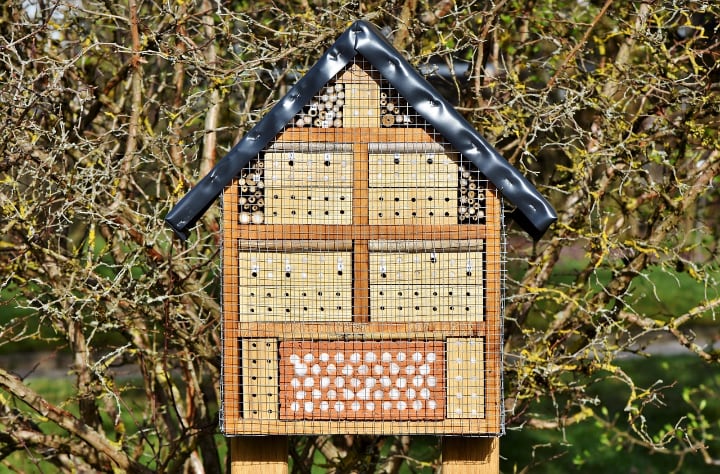
You should look to place your bees house about 1m (3 feet) above ground.
Step 2 – Choose a Material
As we’ve seen, anything can make a good bees house, from a wooden box or tin can to a cinder block. Bees are not half as pretentious as cats.
Step 3 – Set Up the Tubes
You can do this either with dead stems or rolled-up paper or cardboard. Alternatively, you can purchase ready-made bamboo tubes.
Tip: The tubes need to be small. You should aim for a width between 4 to 8 mm.
Step 4 – Set It on a Sturdy Surface
You want the bees house to withstand harsh weather, so make sure you tie it into place, regardless of your chosen location.
That’s it! Bees houses can be complicated, but a basic bees house can take as little as 20 minutes to make.
Where to Put a Bee House
Ideally, the bees house would need to be in a sunny location, either facing south or southwest.
It also needs to be in an area where it will be safe from high winds, which might topple it over.
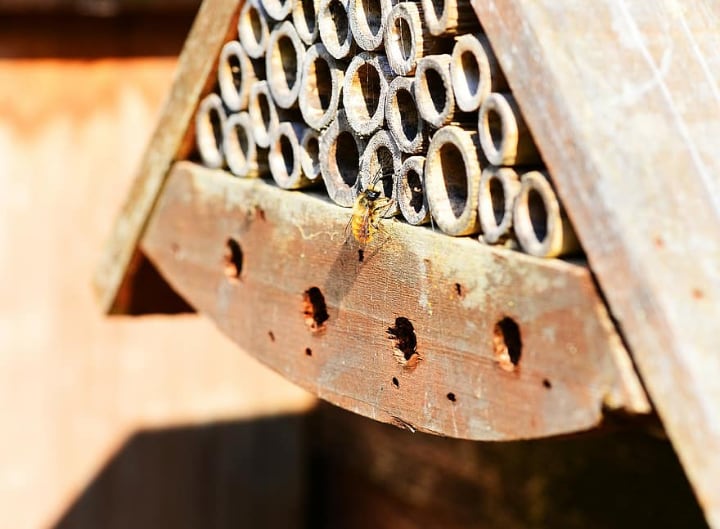
Place your bees house on a flat surface to ensure stability. If it’s possible to tie or root down the bees house for added security, then do so.
What’s the Best Food for Bees?
While you can put things like honey and sugar (both big bee favorites) near or inside of the bees house, the most important part of a bee’s diet is through vegetation.
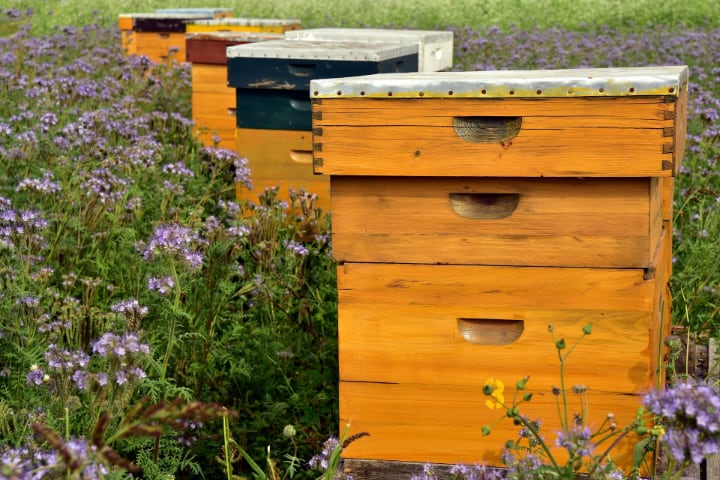
If you want to keep your bees well-fed throughout the year, plant a wide array of wildflowers in your garden, to ensure the bees get the necessary nutrients.
Add a water source, too. Pollen is not a good source, so bees will need more water in their diet. Garden water features can prove handy here.
Important: Bees can’t swim. Your water source needs to be low and accessible from a standing position. You could fill it with pebbles and make sure the water level is low.
Tips for Managing a Bees House
Once your bees house is up and buzzing, you need to look after it. It’s not much of a task, though. Just pay attention to the following tips.
- Keep it dry or mold will form inside the tubes.
- Move the bees house during winter, to protect the larvae from harsh weather.
- Clean the cocoons during the cold months. Rinse the cocoons well with water, to ensure there aren’t any mites pestering them. Don’t worry, bee cocoons are water-proof.
- You can also use a mild bleach solution to clean the outsides of the cocoons.
- Once the larvae have left the house, make sure to properly clean it and replace the tubes (to do away with any parasites that may be living inside).
Bees House for Sale
If you’re not interested in building your own bees house, not to worry. There are plenty of great options for sale.
Mason Bee House – The Hive
Not only is this mason bee house super cute, but it’s also eco-friendly. The rosewood tubes inside give off a natural, earthy scent, which makes it more appealing to the bees.
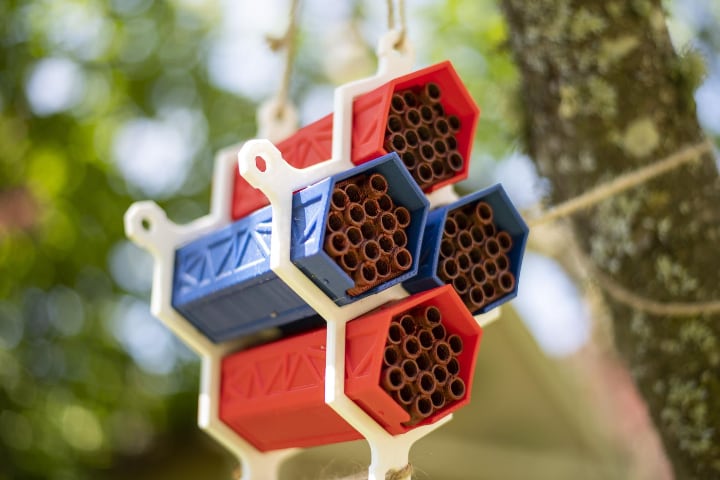
Its simple design makes it ideal if you’re not interested in harvesting cocoons.
Jcs Wildlife Bees House
The great thing about this brightly-colored bees house is that it’s resistant and will keep well even during harsh weather.
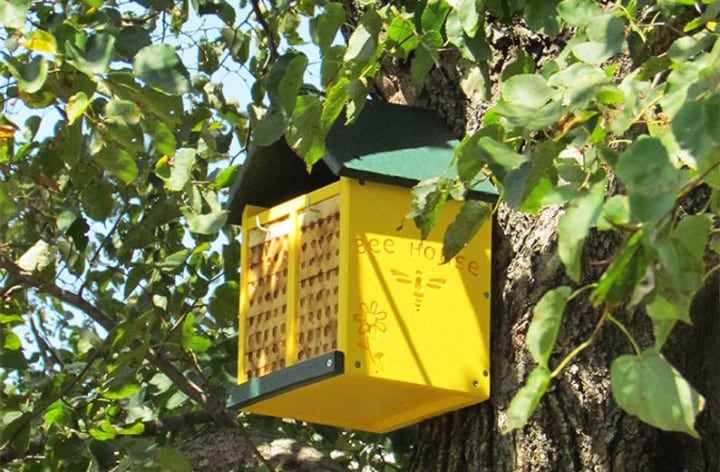
We also love the cute design, as well as the many tubes it has, and which are ideal for a lot of cocoons.
Mason Bees House Handmade
For a more simplistic, natural design, this handmade bees house is the perfect choice. This bamboo bees house is eco-friendly and durable (bamboo is one of the most resistant materials in the world).
Not to mention, it blends in perfectly into most garden designs.
Homestead Essentials Bees House
Another weather-proof option, also made from bamboo, the Homestead Essentials bees house has a more traditional house-y look. It can also house more cocoons, thanks to its impressive (bee-wise) size.
Bees House FAQ
We hoped we answered your key questions about bees houses so far. Check out a few more essential questions below that zoom in on key aspects of owning and managing a bees house.
What attracts bees to my house?
Having a bees house in your garden will be compelling enough for bees to begin with, but if you want to improve your chances, you can use lemongrass oil (which mimics bee pheromone scent), beeswax, or honey to attract them to your home.
What do bees do in a bee house?
Bees bring nectar and pollen to a bee house and then deposit their larvae. In this way, they set up their nest. Learn more about the different types of bees houses.
What kind of bees live in a bee house?
Mainly solitary bees live inside a bee house since they don’t need a hive to survive. Mason bees, orchard bees, and solitary bees all inhabit bee houses and hotels.
What does a bee house look like?
A bee house is a solid structure (made from wood, plastic, or metal), filled with tiny, slim tubes (usually made of reeves, cardboard, or bamboo), in which bees nest. Read more about bee houses.
And That’s How You Build A Bee-Utiful Bees House!
There’s room for diversity and versatility when building a bees house. Aside from sticking to a few basic rules (such as the narrow size of the tubes, for example), all you need to attract bees is the willingness to do so.
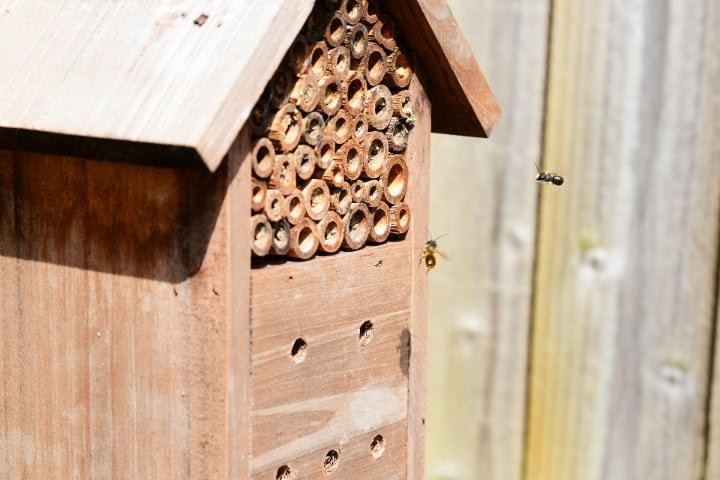
Bees houses are easy to make and constitute a wonderful addition to your garden! If you’ve never had one before, you’re really missing on an opportunity to make friends with the bees.
Create a bees house or buy one ready-made and tells us all about it here or on social media. We look forward to hearing from you

Leave a Reply